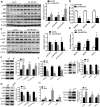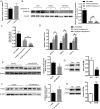Hepatic MiR-291b-3p Mediated Glucose Metabolism by Directly Targeting p65 to Upregulate PTEN Expression
- PMID: 28054586
- PMCID: PMC5214750
- DOI: 10.1038/srep39899
Hepatic MiR-291b-3p Mediated Glucose Metabolism by Directly Targeting p65 to Upregulate PTEN Expression
Abstract
Several studies have suggested an important role of miR-291b-3p in the development of embryonic stem cells. In previous study, we found that the expression of miR-291b-3p was significantly upregulated in the liver of db/db mice. However, the role of miR-291b-3p in glucose metabolism and its underlying mechanisms remain unknown. In the present study, we demonstrated that miR-291b-3p was abundantly expressed in the liver. Of note, hepatic miR-291b-3p expression was upregulated in HFD-fed mice and induced by fasting in C57BL/6 J normal mice. Importantly, hepatic inhibition miR-291b-3p expression ameliorated hyperglycemia and insulin resistance in HFD-fed mice, whereas hepatic overexpression of miR-291b-3p led to hyperglycemia and insulin resistance in C57BL/6 J normal mice. Further study revealed that miR-291b-3p suppressed insulin-stimulated AKT/GSK signaling and increased the expression of gluconeogenic genes in hepatocytes. Moreover, we identified that p65, a subunit of nuclear factor-κB (NF-κB), is a target of miR-291b-3p by bioinformatics analysis and luciferase reporter assay. Silencing of p65 significantly augmented the expression of PTEN and impaired AKT activation. In conclusion, we found novel evidence suggesting that hepatic miR-291b-3p mediated glycogen synthesis and gluconeogenesis through targeting p65 to regulate PTEN expression. Our findings indicate the therapeutic potential of miR-291b-3p inhibitor in hyperglycemia and insulin resistance.
Figures







Similar articles
-
Liver MicroRNA-291b-3p Promotes Hepatic Lipogenesis through Negative Regulation of Adenosine 5'-Monophosphate (AMP)-activated Protein Kinase α1.J Biol Chem. 2016 May 13;291(20):10625-34. doi: 10.1074/jbc.M116.713768. Epub 2016 Mar 24. J Biol Chem. 2016. PMID: 27013659 Free PMC article.
-
MiR-499-5p Contributes to Hepatic Insulin Resistance by Suppressing PTEN.Cell Physiol Biochem. 2015;36(6):2357-65. doi: 10.1159/000430198. Epub 2015 Jul 27. Cell Physiol Biochem. 2015. PMID: 26279439
-
Mir-338-3p Mediates Tnf-A-Induced Hepatic Insulin Resistance by Targeting PP4r1 to Regulate PP4 Expression.Cell Physiol Biochem. 2017;41(6):2419-2431. doi: 10.1159/000475912. Epub 2017 May 3. Cell Physiol Biochem. 2017. PMID: 28467989
-
MicroRNA-20a-5p contributes to hepatic glycogen synthesis through targeting p63 to regulate p53 and PTEN expression.J Cell Mol Med. 2016 Aug;20(8):1467-80. doi: 10.1111/jcmm.12835. Epub 2016 Mar 28. J Cell Mol Med. 2016. PMID: 27019188 Free PMC article.
-
MiR-291b-3p induces apoptosis in liver cell line NCTC1469 by reducing the level of RNA-binding protein HuR.Cell Physiol Biochem. 2014;33(3):810-22. doi: 10.1159/000358654. Epub 2014 Mar 21. Cell Physiol Biochem. 2014. PMID: 24685524
Cited by
-
Toll-Interacting Protein in Pulmonary Diseases. Abiding by the Goldilocks Principle.Am J Respir Cell Mol Biol. 2021 May;64(5):536-546. doi: 10.1165/rcmb.2020-0470TR. Am J Respir Cell Mol Biol. 2021. PMID: 33233920 Free PMC article. Review.
-
MiR-1286 inhibits lung cancer growth through aerobic glycolysis by targeting PKM2.Arch Med Sci. 2019 Sep 18;19(1):151-159. doi: 10.5114/aoms.2019.87812. eCollection 2023. Arch Med Sci. 2019. PMID: 36817669 Free PMC article.
-
Analysis of microRNA expression in cerebral ischemia/reperfusion after mild therapeutic hypothermia treatment in rats.Ann Transl Med. 2021 Jan;9(2):168. doi: 10.21037/atm-21-143. Ann Transl Med. 2021. PMID: 33569470 Free PMC article.
-
Hyaluronic acid 35 normalizes TLR4 signaling in Kupffer cells from ethanol-fed rats via regulation of microRNA291b and its target Tollip.Sci Rep. 2017 Nov 15;7(1):15671. doi: 10.1038/s41598-017-15760-4. Sci Rep. 2017. PMID: 29142263 Free PMC article.
-
miR-291b-3p mediated ROS-induced endothelial cell dysfunction by targeting HUR.Int J Mol Med. 2018 Nov;42(5):2383-2392. doi: 10.3892/ijmm.2018.3821. Epub 2018 Aug 10. Int J Mol Med. 2018. PMID: 30106126 Free PMC article.
References
-
- Chakraborty C., Doss C. G., Bandyopadhyay S. & Agoramoorthy G. Influence of miRNA in insulin signaling pathway and insulin resistance: micro-molecules with a major role in type-2 diabetes. Wiley interdisciplinary reviews. RNA 5, 697–712 (2014). - PubMed
Publication types
MeSH terms
Substances
LinkOut - more resources
Full Text Sources
Other Literature Sources
Research Materials
Miscellaneous

